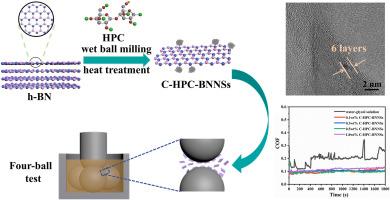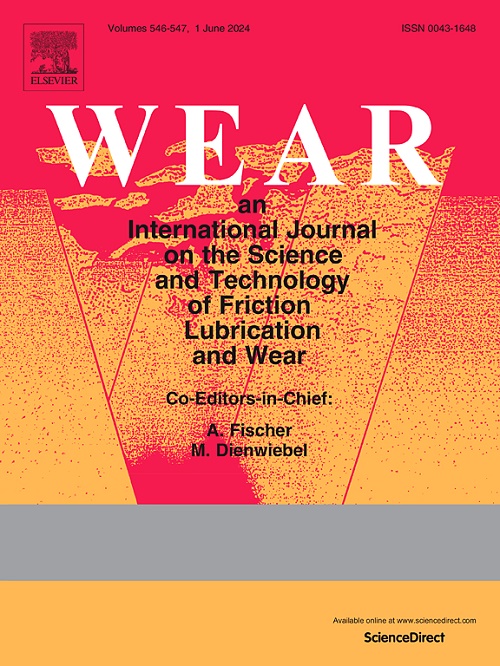Fabrication of surface-carbonated boron nitride nanosheets and their application as water-based lubrication additives
IF 5.3
1区 工程技术
Q1 ENGINEERING, MECHANICAL
引用次数: 0
Abstract
As a typical two-dimensional layered material, hexagonal boron nitride nanosheets (BNNSs) have high mechanical strength, good conductivity, and excellent lubrication performance, which have great potential as solid nano lubricant additives in tribology. When BNNS is used as a water-based or oil-based lubricant additive, its inherent chemical inertness and poor dispersion stability make it difficult to achieve optimal anti-friction and anti-wear performance. In this paper, a simple and efficient preparation method for obtaining hexagonal boron nitride nanosheets (C-HPC-BNNSs) with surface carbonization modification and excellent dispersion stability in water-based lubricants was proposed. Using hydroxypropyl cellulose (HPC) as a modifier, a wet ball milling process combined with high-temperature carbonization treatment effectively reduced the thickness of BNNSs while uniformly modifying N-doped carbon layers on the surface of the nanosheets. Benefit from the smaller layer thickness of C-HPC-BNNSs, they exhibit excellent dispersion stability in the water-glycol solution and can maintain no significant agglomeration behavior for up to 30 days, which is the basis for the excellent lubrication performance of lubricant systems. In addition, the N-doped carbon layer modified on the surface is beneficial for enhancing the hydrophilicity of BNNSs and synergistically enhances the tribological properties of the material with BNNSs. The test results of the four-ball friction tester show that compared with the pure water-glycol solution and the water-glycol system with added C-HPC-BNNSs, the friction coefficient (COF) and wear volume of the system with added C-HPC-BNNSs could be as low as 0.095 and 1.99 × 10−4 mm3, respectively. This work has positive significance for the preparation, surface modification, and tribological application expansion of two-dimensional layered material BNNSs, which is conducive to further understanding the relationship between.

表面碳化氮化硼纳米片的制备及其作为水基润滑添加剂的应用
作为一种典型的二维层状材料,六方氮化硼纳米片(BNNS)具有很高的机械强度、良好的导电性和优异的润滑性能,在摩擦学中作为固体纳米润滑添加剂具有很大的潜力。当 BNNS 用作水基或油基润滑油添加剂时,其固有的化学惰性和较差的分散稳定性使其难以达到最佳的抗摩擦和抗磨损性能。本文提出了一种简单高效的制备方法,以获得表面碳化改性且在水基润滑剂中具有优异分散稳定性的六方氮化硼纳米片(C-HPC-BNNSs)。以羟丙基纤维素(HPC)为改性剂,采用湿球研磨工艺结合高温碳化处理,在均匀改性纳米片表面的掺氮碳层的同时,有效降低了氮化硼纳米片的厚度。得益于 C-HPC-BNNSs 较小的层厚度,它们在水-乙二醇溶液中表现出优异的分散稳定性,并能在长达 30 天的时间内保持无明显团聚行为,这也是润滑油系统具有优异润滑性能的基础。此外,表面修饰的掺杂 N 的碳层有利于增强 BNNSs 的亲水性,并与 BNNSs 协同增强材料的摩擦学性能。四球摩擦试验机的测试结果表明,与纯水-乙二醇溶液和添加了 C-HPC-BNNSs 的水-乙二醇体系相比,添加了 C-HPC-BNNSs 的体系的摩擦系数(COF)和磨损体积可分别低至 0.095 和 1.99 × 10-4 mm3。该研究对二维层状材料BNNSs的制备、表面改性和摩擦学应用拓展具有积极意义,有利于进一步理解二维层状材料BNNSs与C-HPC-BNNSs之间的关系。
本文章由计算机程序翻译,如有差异,请以英文原文为准。
求助全文
约1分钟内获得全文
求助全文
来源期刊

Wear
工程技术-材料科学:综合
CiteScore
8.80
自引率
8.00%
发文量
280
审稿时长
47 days
期刊介绍:
Wear journal is dedicated to the advancement of basic and applied knowledge concerning the nature of wear of materials. Broadly, topics of interest range from development of fundamental understanding of the mechanisms of wear to innovative solutions to practical engineering problems. Authors of experimental studies are expected to comment on the repeatability of the data, and whenever possible, conduct multiple measurements under similar testing conditions. Further, Wear embraces the highest standards of professional ethics, and the detection of matching content, either in written or graphical form, from other publications by the current authors or by others, may result in rejection.
 求助内容:
求助内容: 应助结果提醒方式:
应助结果提醒方式:


